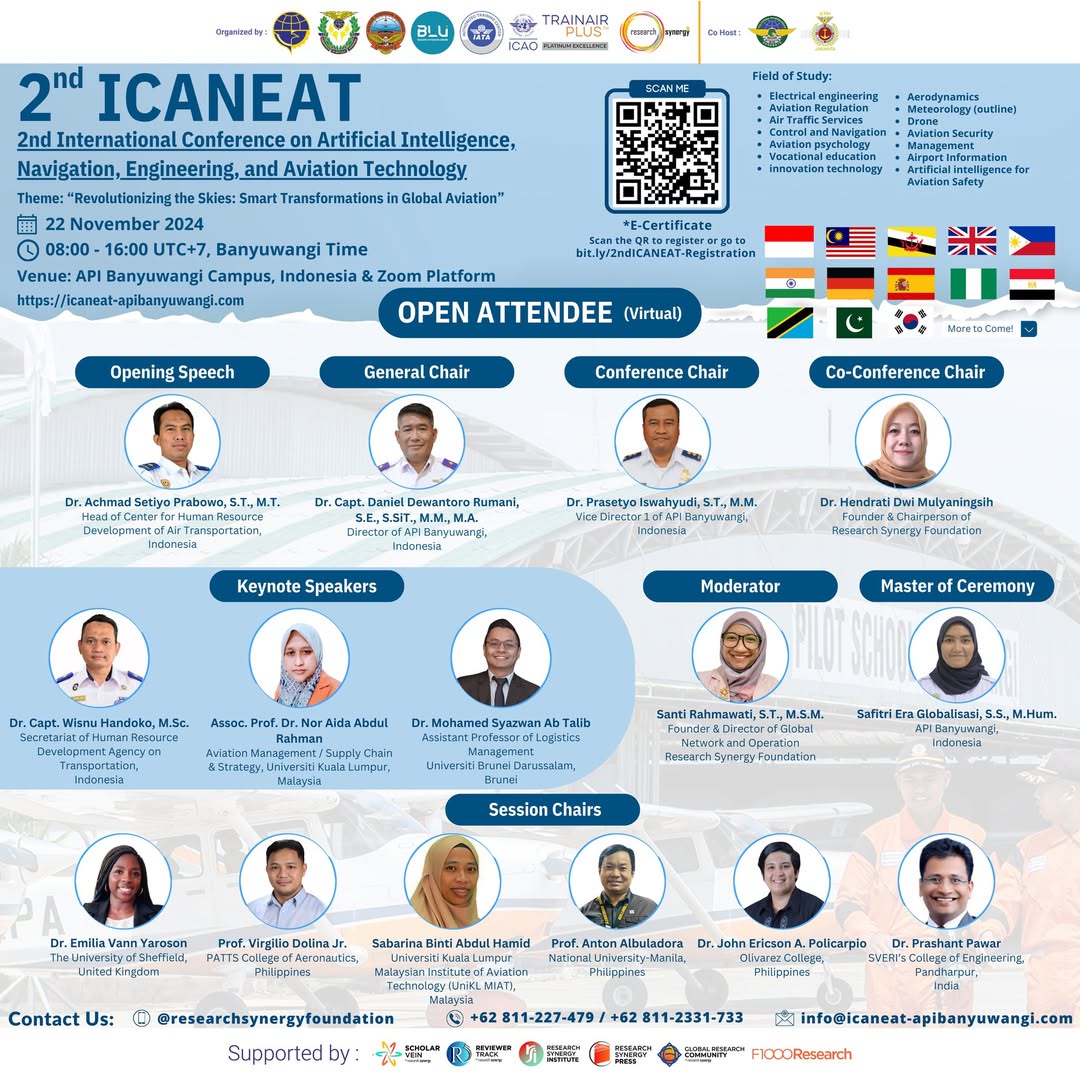A Review of Radio Communication Range for Air Traffic Services
Keywords:
radio coverage, situational awareness, ATCAbstract
OJT activity is an activity of the Higher Education Tridharma (Education, Research and Community Service) which aims to get to know and add insight and scope of work according to the field of assignment, as well as an encouragement to cadets to be able to work individually or work in a team competently. the data carried out in this research is based on the author's observations and data on the ATS Operational Logbook Unit Approach Control Procedural Airnav Tarakan Branch from September to December 2022, so as to obtain results. In carrying out their duties, ATC really needs situational awareness related to matters regarding ATC internal and external conditions. Based on the author's observations during OJT, traffic conditions at Juwata International Airport are very high. However, the radio communication range used by ATC is less than optimal, causing consequences that can interfere with the comfort of flight traffic services.
References
AIM Indonesia. 2022. WAQQ Aeronautical Information Publication (Vol II). AIP Indonesia.
[2] AirNav Indonesia. 2019. Approach Control Service Standard Operating Procedure (APP). Tarakan : Perum LPPNPI Tarakan Branch.
[3] AirNav. Indonesia. 2021. Letter of Operational Coordination Agreement. Tarakan : Perum LPPNPI Tarakan Branch.
[4] Ardhiani, L. N., Kumala, G. R., & Perdana, N. M. (2019). Analisis Kualitatif Penerapan Situation Awareness Pada Aktivitas Kerja Air Traffic Controller (ATC). Seurune: Jurnal Psikologi Unsyiah, 2(1), 16-32.
[5] Bateman, A. J., Burkholder, J., Summers, T., & Richards, N. D. (2019). Incorporating RF Coverage Analysis in Mission Planning for Future Airspace Operations. In AIAA Scitech 2019 Forum (p. 1059).
[6] Bearman, C., Paletz, S. B., Orasanu, J., & Thomas, M. J. (2017). The breakdown of coordinated decision making in distributed systems. In Decision Making in Aviation (pp. 329-344). Routledge.
[7] Dowden, T., Pittaway, S., Yost, H., & McCarthy, R. (2013). Students’ perceptions of written feedback in teacher education: Ideally feedback is a continuing two-way communication that encourages progress. Assessment & Evaluation in Higher Education, 38(3), 349-362.
[8] Edwards, T., Sharples, S., Wilson, J. R., & Kirwan, B. (2012). Factor interaction influences on human performance in air traffic control: The need for a multifactorial model. Work, 41(Supplement 1), 159-166.
[9] Endsley, M. R. (1995). Toward a theory of situation awareness in dynamic systems. Human factors, 37(1), 32-64.
[10] ICAO. 2016. Document 4444 – Sixteenth Edition, Air Traffic Management. Canada : International Civil Aviation Organization (ICAO)
[11] ICAO. 2016. Annex 10 – Seventh Edition, Aeronautical Telecommunications, Volume II Communication Procedures Including those with PANS. Canada : International Civil Aviation Organization (ICAO).
[12] ICAO. 2018. Annex 11 – Fifteenth Edition, Air Traffic Services. Canada : Internatinal Civil Aviation Organization (ICAO).
[13] International Civil Aviation Organization. (1993). HUMAN FACTORS DIGEST No. 8: Human Factors in Air Traffic Control. ICAO Circular 241-AN/145, 51.
[14] Kaber, D. B., Perry, C. M., Segall, N., McClernon, C. K., & Prinzel III, L. J. (2017). Situation awareness implications of adaptive automation for information processing in an air traffic control-related task. In Situational Awareness (pp. 361-376). Routledge.
[15] Lambert, V. a., & Lambert, C. E. (2013). Qualitative Descriptive Research: An Acceptable Design. Pacific Rim International Journal of Nursing Research, 16(4), 255–256.
[16] LaRiviere, J., & Lyu, X. (2022). Transmission constraints, intermittent renewables and welfare. Journal of Environmental Economics and Management, 112, 102618.
[17] Lieska, K., Laitinen, E., & Lahteenmaki, J. (1998, September). Radio coverage optimization with genetic algorithms. In Ninth IEEE International Symposium on Personal, Indoor and Mobile Radio Communications (Cat. No. 98TH8361) (Vol. 1, pp. 318-322). IEEE.
[18] Majumdar, A., & Ochieng, W. Y. (2002). Factors affecting air traffic controller workload: Multivariate analysis based on simulation modeling of controller workload. Transportation Research Record, 1788(1), 58-69.
[19] Moriarty, D., & Jarvis, S. (2014, February). Trade-Offs as symptoms of mismatches between sociotechnical systems: a case study involving commercial aviation and air traffic control. In 5TH SYMPOSIUM ON RESILIENCE ENGINEERING MANAGING TRADE-OFFS (p. 221).
[20] Morris, S., & Shin, H. S. (2007). Optimal communication. Journal of the European Economic Association, 5(2-3), 594-602.
[21] Morris, W., The American Heritage Dictionary
Downloads
Published
Issue
Section
License
Copyright (c) 2024 Aditya Dwi Sanjaya , Dwi Lestary (Author)

This work is licensed under a Creative Commons Attribution-ShareAlike 4.0 International License.









